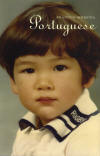Portuguese
Witty to no end, Brandon Shimoda writes smart-ass hipster poems. The title of his latest collection, Portuguese, stems from a first day of first grade childhood teasing incident on the school bus when he was mocked by a “a fourth grader, skinny, with grassy blond hair and the face of a horse” who drawled out “in a squealing voice, Portugueeese, Portugueeese!” Shimoda is not in the least Portuguese. However, the incident not only gives him the title of this collection but clearly shapes the irony and humor that run throughout, along with for better or worse contributing to his larger views regarding humanity. One way or another, the event led as well to his researching “words of Portuguese origin introduced into the Japanese language, mostly by Portuguese Jesuit priests.” The list is a curious wonder in itself, at once as much practical as fanciful:
Witty to no end, Brandon Shimoda writes smart-ass hipster poems. The title of his latest collection, Portuguese, stems from a first day of first grade childhood teasing incident on the school bus when he was mocked by a “a fourth grader, skinny, with grassy blond hair and the face of a horse” who drawled out “in a squealing voice, Portugueeese, Portugueeese!” Shimoda is not in the least Portuguese. However, the incident not only gives him the title of this collection but clearly shapes the irony and humor that run throughout, along with for better or worse contributing to his larger views regarding humanity. One way or another, the event led as well to his researching “words of Portuguese origin introduced into the Japanese language, mostly by Portuguese Jesuit priests.” The list is a curious wonder in itself, at once as much practical as fanciful:
those [words] for the underwear worn beneath a kimono; star-shaped candy; mummy; shaddock (fruit); sponge cake; cactus; (the Christian) cross; caramel; Christian (people); (religious) missionary; quince; soap; marbles; flask; (cigarette) tobacco; Jesus (Christ); and a certain type of small biscuit.
It’s also both worthwhile and interesting to note that Shimoda wrote many of these poems “while riding the 3, 8, 27, 36, 39, 66, and 70 bus lines in and around Seattle . . . inspired by their passengers—their voices and minds, their faces and bodies, their exuberances and infirmities.” He weaves these disparate voices and images into lines juxtaposing various perspectives with a chaotic seamlessness which suits today’s age, and he manages get in his digs against his childhood bully in “Black for Light Years”:
Do you know Marcel? Abir says he has a pussy!
Abir IS a pussy. You’re supposed to love him!
He’s supposed to fuck me with these clothes on
He’s SWAMP! I want to shoot him in his head
You can see black for LIGHT YEARS
That’s my cousin’s baby
That’s fucking MAN-WELL!
That nigga’s just big for NO REASON
Yesterday, MAN-WELL was like, That’s why you’re having a baby
That’s bestiality
She said my baby looked like a fucking monkey
I said, Bitch, Your baby looks like a MARE
And you look like a HORSE
Other poems expand beyond merely being documentation of found dialogue. When they do, Shimoda betrays that he believes in something further than his casual display of ironic detachment would at first lead readers to guess. In these instances, the poems engage with deeper sets of concerns than the jokey one-liners strung together that form the bulk of the work here. It’s possible to catch sight of Shimoda stepping outside of comfortable zones of displacement common to the hipster poem and entering into dialogue of a much larger order, as in “poems [ If we were all characterized as colors, and colors were insatiable ]”:
Children need art to better express the things caught within them. No
Children need art to better understand
That there are things that require expression. No
Children need art to better think their way toward understanding
Their faults, not those of their broken supplies
Nor the embodiment of the bisexual vegetable. No
Children need art to frame the battling crests of contemporary motion. No
Children need art to commandeer a sense of history
For their own senses. No
Children need art to outpace the bullish advances of history. No
Children need art to abandon the idea that history is an expression of things—
the saucers look nice, as do the wigs and Portuguese guns, but history as shown in this castle is nothing if not infinitely replaceable. Art, however, is eternally salient, gives not color to history but history to itself, and is what we have to represent both the radiation and shadow of history.
In the end, to no surprise, the “smart-ass hipster poem” style wins out here. Whether it ultimately wins out in the future of poetry is a different, yet-to-be-decided, matter. Shimoda’s playfulness with the form of the poems in terms of construction and his intriguing interest in weaving together what appear to be open-ended poem-series demonstrate his obviously promising poetic skill. Scattered sections/pieces/individual poems (it’s unclear how Shimoda conceives of and/or intends the arrangement to be taken) which share the same title appear throughout the book. Some titles appearing multiple times include: “The Grave on the Wall,” “for the people,” “from Yellow Picnic,” “The Cedars of Lebanon,” “poems.” This reads as a maneuver which is more than mere gimmick. Note that while these may be “hipster” poems, they are not slacker poems. What’s accomplished here is poetry well done. Shimoda’s no doubt a poet who speaks to the era in which we live.





